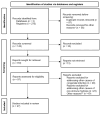Parvovirus B19 in Pregnancy-Do We Screen for Fifth Disease or Not?
- PMID: 39768374
- PMCID: PMC11678740
- DOI: 10.3390/life14121667
Parvovirus B19 in Pregnancy-Do We Screen for Fifth Disease or Not?
Abstract
Parvovirus B19 (B19V) infection is the cause of erythema infectiosum, or the "fifth disease", a widespread infection, potentially affecting 1-5% of pregnant women, in most cases without significant damage to the pregnancy or fetus. It follows a seasonal variation, with a higher prevalence in temperate climates, mainly in late winter and early spring. Women at increased risk include mothers of preschool and school-age children, and those working in nurseries, kindergartens, and schools. Vertical transmission occurs in 33% to 51% of cases of maternal infection. Parvovirus infection is an important cause of fetal perinatal infection resulting in increased morbidity through the development of fetal anemia, heart failure, and non-immune hydrops. A comprehensive literature review was conducted using PubMed, Cochrane Library, and Google Scholar, focusing on publications from the last 10 years and prioritizing studies related to parvovirus B19 infection in pregnancy. We summarized the existing data in the literature on the effects of parvovirus B19 infection during pregnancy and weighed if there is a need for screening in pregnant patients. Routine screening for parvovirus B19 infection can be considered in communities where infection is common, there is occupational exposure, or during endemic periods, with the reason being that accurate identification and treatment of fetuses affected by congenital B19V infection have been shown to improve perinatal outcomes.
Keywords: fifth disease; infection; parvovirus; pregnancy.
Conflict of interest statement
The authors declare no conflicts of interest.
Figures




References
-
- Auriti C., De Rose D.U., Santisi A., Martini L., Piersigilli F., Bersani I., Ronchetti M.P., Caforio L. Pregnancy and viral infections: Mechanisms of fetal damage, diagnosis and prevention of neonatal adverse outcomes from cytomegalovirus to SARS-CoV-2 and Zika virus. Biochim. Biophys. Acta Mol. Basis Dis. 2021;1867:166198. doi: 10.1016/j.bbadis.2021.166198. - DOI - PMC - PubMed
Publication types
LinkOut - more resources
Full Text Sources

